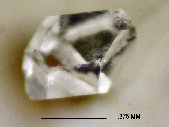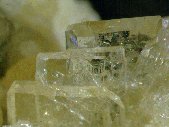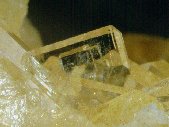Thumbnails

Fluoroapophyllite crystal
© Doug Merson

Fluoroapophyllite crystals
© Quintin Wight

Fluoroapophyllite crystals
© Quintin Wight
KCaSi20(F,OH) · 8H
Fluorapophyllite is the dominant member of the two members of the apophyllite series at Mont Saint-Hilaire. It occurs in well formed crystals up to 6cm, though the majority are in the 1 to 6mm range.
PHYSICAL CHARACTERISTICS:
Color is generally colorless, less frequently white, pale gray, pale
green, rarely pale yellow and very seldom pale pink.
Luster is vitreous, except for etched pinacoids.
Diaphaneity is transparent to translucent.
Crystal System is tetragonal; 4/mnc
Crystal Habits include square tabular in larger crystals and a pseudo-
octahedral in smaller crystals.
Cleavage: {001} is perfect and {110} is imperfect.
Fracture is uneven.
Hardness is 4.5 to 5
Specific Gravity is approximately 2.4g/cm
Streak is white.
Associated Minerals include aegirine, albite, amphibole group,
ancylite, biotite, calcite, catapleiite, fluorite, galena, molybdenite,
narsarsukite, natrolite, pectolite, quartz, titanite, vesuvianite and
zircon.
Distinguishing Features: Crystal habit. Fluoresces bright green under
SW and pale yellow under LW.
Origin: Named in 1800, apophyllite comes from the Greek apo, away
and phyllazein, to get leaves, alluding to its exfoliation when heated in
a blowpipe. The end members of the series were coined in 1978.
Fluorapophyllite was named to reflect its fluorine rich composition.
CLASSIFICATION:
Dana System
# 72.3.1.1
Strunz Classification
# VIII/H.01-20
REFERENCES:
MinRec 21:310 (1990), Dana 8:1525-1527 (1997)
DISTRIBUTION AND RARITY AT MONT SAINT-HILAIRE:
MSH
¤¤¤
